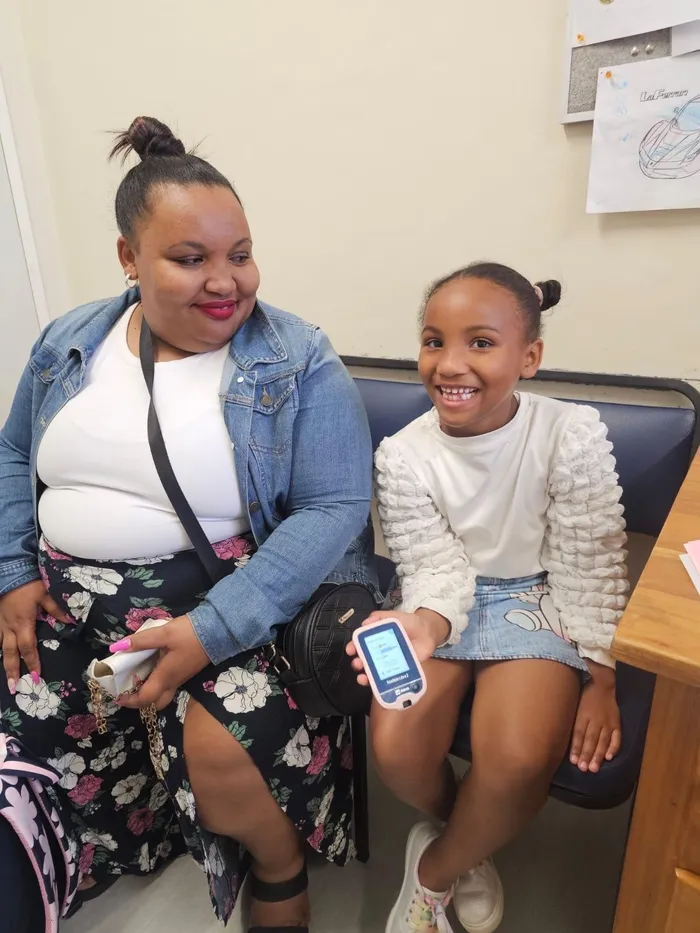Campaign calls for life-saving diabetes technology for South African children

Monique Abrahams and her daughter Maleah-Jane have seen the enormous benefits of a Continuous Glucose Monitoring device.
Image: Supplied
Every parent shares an instinctive desire to protect their children, but for those caring for kids with Type 1 diabetes, this instinct often morphs into anxiety during the night. A simple yet agonising dilemma unfolds as parents must decide whether to wake their sleeping children to conduct finger prick tests that monitor glucose levels. Yet, the alternative - diabetic ketoacidosis - looms ominously, adding to their worries.
This precarious balancing act of care is underscored by the slow but steady rise of a transformative campaign advocating for the inclusion of Continuous Glucose Monitors (CGMs) in South Africa's public healthcare system for children under 18. Internationally recognised as the gold standard of care for managing diabetes, CGMs continuously monitor glucose levels without the need for painful finger pricks, promising a more stable and secure form of diabetes management for families.
Families like that of Monique Abrahams have begun to see the profound impact of CGMs. Monique says, “This continuous glucose monitor not only aids in checking glucose levels, but has saved my daughter's life on multiple occasions from dangerous glucose events. The warning alarm gives us enough time to act in the midst of being on the road and in our busy lives.”
Her remarks echo the sentiments of many parents navigating the treacherous waters of Type 1 diabetes.
With the use of CGMs, Abrahams has managed to lower her daughter’s HbA1c level from a concerning 14 to an impressive six. This significant improvement is not just numbers on a paper; it represents an enhanced quality of life and stability for the child, who otherwise endures a never-ending cycle of finger pricks, injections, and interrupted sleep.
“The sensor has taught my six-year-old how to make meal choices when I am not present and also takes the burden off the educator. The use of the sensor should not be optional - it is mandatory,” she says.

Kirsten de Klerk, Co-Founder of SA Diabetes Advocacy, says a CGM means that children and parents can enjoy peace of mind and don’t have to interrupt play, learning, or sleep.
Image: Supplied
Supporters of the campaign, such as Kirsten de Klerk, Co-Founder of SA Diabetes Advocacy, echo Abrahams' concerns, adding, “A CGM means that children and parents can enjoy peace of mind and don’t have to interrupt play, learning, or sleep, which is so important to cognitive development and well-being.”
For many, CGM technology signifies more than just medical equipment; it represents a leap towards freedom for parents and a more carefree childhood for their children.
The campaign, supported by many diabetes advocacy groups, has gained considerable traction since its inception. Earlier this year, SA Diabetes Advocacy, alongside organisations like Diabetes SA and Kids Powered by Insulin, launched a petition aimed at prompting the government to act. With over 6 800 signatures gathered thus far, their goal is clear: to reach 10 000 signatures before the hands of the clock strike the 2025 Diabetes Summit set for 11 November. The petition will call on the National Department of Health to take decisive action regarding CGM accessibility.
Research by Discovery Health underscores the potential of CGMs not only to transform lives but also to represent a smart investment for the healthcare system. Their findings reveal that CGM users demonstrate better glucose control and have fewer hospital visits - 64.9% of children using CGMs achieved normal HbA1c results, compared to just 39.2% of those without access to these devices.
Shiara Pillay, Director of SA Diabetes Advocacy and diagnosed with diabetes at a young age, reflects on this reality. “My conversations with my doctors have improved so much because they have more data on my trends and reactions,” she says, attributing much of her quality of life and overall well-being to her CGM device.
With the petition's handover date rapidly approaching, the campaign must gather over 100 new signatures each day to reach their ambitious target. With the stakes so high - “Every child deserves the chance to thrive, to go to school without fear, and to sleep safely at night,” says De Klerk - public support is crucial. Interested individuals can participate in this pivotal movement by visiting the petition site - https://www.diabetesadvocacy.org.za/cgm-access-petition - and adding their name to the cause.